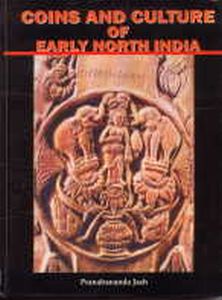
Contents: Acknowledgements. System of transliteration. Introduction. 1. Early Indian coins. 2. Tribal and local coins. 3. Indo-Greek coins. 4. Scytho-Arthian coins. 5. Kushana coins. 6. Gupta coins. 7. Post-Gupta coins. 8. Yaksha-Yakshini on coins. 9. Sri-Lakshmi on coins. 10. The Rama-Tankas. Select Bibliography. Index.
"The present work strives to reflect through the prisms of coins - the forces at work in the realm of religion and culture in early North Indian history.
The extraordinary assimilated genius of India is imprinted on her coins struck throughout the ages, stretching from its genesis to the modern times. The study is primarily concerned with early North Indian coinage highlighting the religio-cultural scenario. It includes the history as reflected on the punch-marked, tribal or local or Janapada, Indo-Greeks, Scytho Parthian, Kushana, Gupta and Post-Gupta coinages and the Rama-Tankas. An in-depth analysis of beautiful and artistic tiny metallic pieces is bound to unveil a magic in the minds of the researchers.
In fact, the study of coins, by and large has concentrated on the chronology of coins, their relationship with political power and the geographical space of the findings, but the work under review offers adequate light on the artistic form of the coins, both figurative and also abstract motifs.
A large number of relevant photographs of the coins have been illustrated in the plates portraying the complex cultural and ethnic set up of the space and time. Moreover, men and women of various social and economic strata of life - kings and Aristocrats, courtly and fashionable ladies of high society, foreigners (Greeks, Parthians, Sakas, Kushanas, etc.) with their distinctive ethnic and/or facial features, costumes and dress, ornaments, hair decoration etc., are richly represented.
Besides historical information, these pieces disseminate an index of secularism where various races and ethnic groups holding apparently different religious faiths and beliefs, rites and rituals could maintain peaceful co-existence. This idea is powerfully brought home while analyzing the bearings of the images and icons on the Rama Tankas issued by the rulers as well as the religious or monastic heads of different ethnic groups." (jacket)